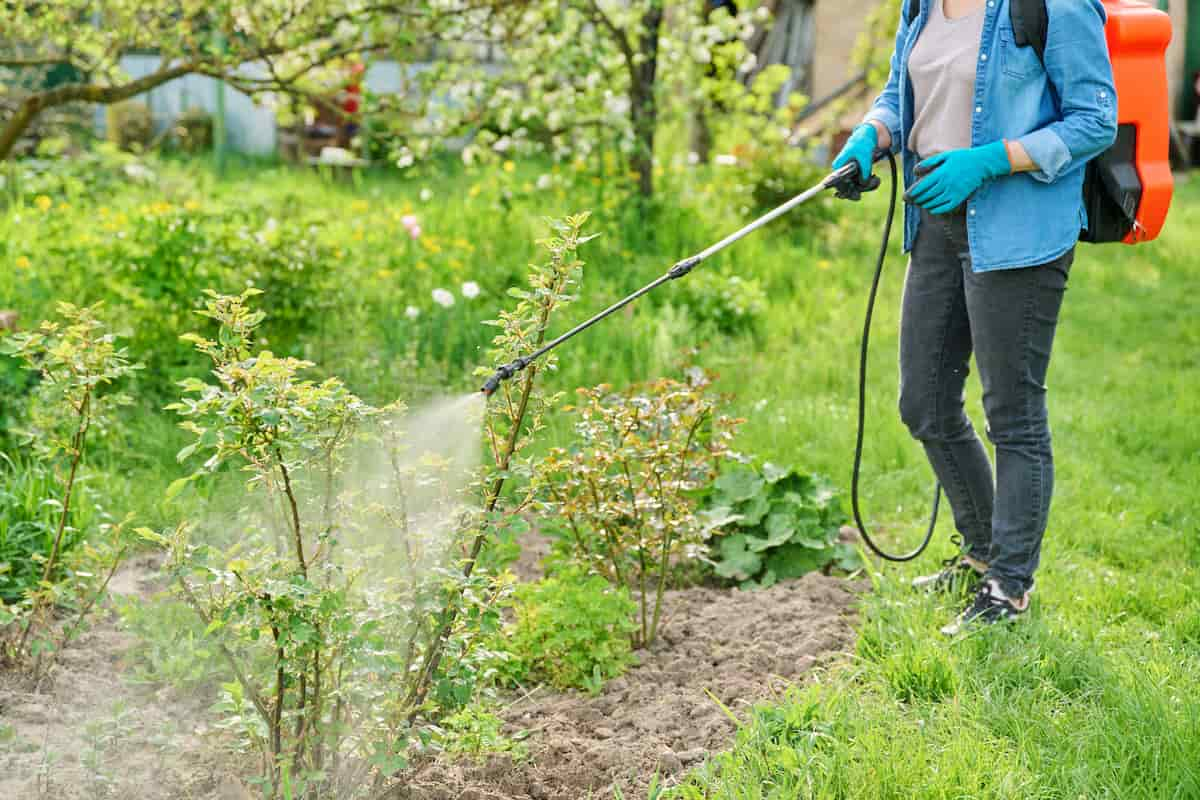The Rose Blackfly, Aleurocanthus rosae, belonging to the Family Aleyrodidae of the Order Hemiptera, is a serious pest that causes significant yield losses and reduces the quality of crops worldwide. It is named blackfly due to its black appearance at the pupal stage. It is generally known as a greenhouse whitefly because of its white wings. The pest feeds on the plant’s sap causing damage to the leaves and reducing the plant’s overall health and vigor.

Effective management strategies are essential to minimize the impact of this pest on rose production. To effectively manage this pest, it is necessary to understand its life cycle, its preferred habitats, and the best methods for controlling it. This article will provide an overview and discussion of the Rose Blackfly Pest in Rose crops, including its symptoms, identification techniques, and control.
Rose Blackfly Pest Management
Life Cycle of Rose Blackfly Pest in Rose Crop
The life cycle of the Rose Blackfly pest has four stages. They are egg, larva, pupa, and adult. The lifecycle of the Rose Blackfly begins when the female lays eggs on the lower side of rose leaves. The eggs hatch after about five to seven days, depending on temperature and humidity. The larvae begin feeding on the sap of the plant and secrete a sticky substance known as honeydew.
As they feed and grow, the larvae develop a more distinct body shape and resemble small, wingless insects. They molt several times before reaching the pupal stage. The pupal stage is the most distinctive stage of the blackfly, as the pupae have a black appearance. They are usually found on the lower side of rose leaves but can also be found on stems and flowers.
The pupal stage lasts about ten days, during which the insect undergoes a complete metamorphosis. Once the pupal stage is complete, the blackfly emerges as an adult. The wings are placed flat over the body when at rest. The adults can fly and move between plants, allowing infestations to spread quickly. The entire lifecycle of the Rose Blackfly Pest takes about 20 to 30 days, depending on environmental conditions, and can produce multiple generations in a single season.
Occurrence of Rose Blackfly Pest in Rose Crop
- Location of Rose Blackfly Pest: This pest infests Rose crops in India, Africa, Sri Lanka, China, Thailand, Vietnam, Indonesia, the United States, Mexico, Brazil, Colombia, Ecuador, the Philippines, and Australia.
- Host Range: The Rose Blackfly pest infects crops like Roses, Citrus, Grapes, Hibiscus, Geraniums, Fuchsias, Tomatoes, Peppers, and Eggplants.
Factors Favoring the Population Increase of Rose Blackfly Pest in Rose Crop
- Warm Temperature – The blackfly thrives in warm temperatures ranging from 20-30°C.
- High Humidity – The blackfly is highly active during periods of high humidity, such as during rainy seasons or in greenhouses.
- Lack of Natural Predators – The blackfly can reproduce quickly without natural predators, such as ladybugs and lacewings.
- Monoculture – In monoculture rose crops, the pest can quickly spread from plant to plant, leading to widespread infestations.
- Poor Plant Health – Weak and stressed plants are more susceptible to blackfly infestation.
Identification of Rose Blackfly Pest in Rose Crop
- Egg: The eggs are white or pale yellow and are oval-shaped.
- Larva: The larvae are small and transparent, with six legs.
- Pupa: The pupae are oval-shaped and are 1.5 mm long.
- Adult: The adult is 1.5 to 2.5 mm long and has a black body with white wings.
Damage Symptoms of Rose Blackfly Pest in Rose Crop
- The characteristic symptom of the blackfly is the presence of black oval pupae on the lower surface of the leaves.
- The blackfly feeds on the sap of the leaves, resulting in stunted growth, yellowing of leaves, and reduced flower production.
- They secrete a sugary substance while feeding called the honeydew, which encourages the growth of the sooty mold.
- It is particularly damaging to young plants and can cause severe infestations.
In case you missed it: Rose Thrips Pest Management: Symptoms, Treatment, Chemical, Biological, and Organic Control

Percentage of Yield Loss in Roses Due to Rose Blackfly Pest
- In India, the yield losses due to Rose Blackfly pests are 70%. In Thailand, the percentage of yield loss is 35%. In Vietnam, the losses are 40%. In Sri Lanka, the losses are 30%. In Indonesia, the losses are 50%. In Africa, it is 80%. In the United States, it is 50%. In Mexico, it is 40%. In Brazil, it is 30%. In China, it is 60%.
- In Colombia, the losses are 60%. In Ecuador, it is 30%. In Australia, it is 35%. In the Philippines, the yield losses are 40%. The Economic Threshold Level (ETL) for the Rose Blackfly pest is set at 10-15 blackflies per leaf.
Blackfly Pest Management in Rose by Cultural Control
- Soil Management – Maintain proper drainage, avoid over-fertilization, and control soil acidity to promote plant health and vigor.
- Sanitation – Removing and destroying infested plant parts, weeds, and debris will reduce the food sources and breeding sites for the blackflies.
- Pruning – Pruning should be done early in the season before the pest populations become too large.
- Companion Planting – Plant marigolds, garlic, chives, and onions that repel or deter the blackfly pest.
Blackfly Pest Management in Rose by Biological Control
- Predators – Predators like ladybugs and green lacewings feed on adult blackfly pests.
- Parasitoids – Parasitic wasps like Encarsia formosa and Eretmocerus eremicus lay their eggs inside the immature stages of the blackfly and kill them.
- Entomopathogenic Fungi – Entomopathogenic fungi, such as Beauveria bassiana, Isaria fumosorosea, and Metarhizium anisopliae, infect and kill the blackflies.
Blackfly Pest Management in Rose by Chemical Control
- Spray Insecticides on the crops like Carbaryl, Malathion, Acetamiprid, Clothianidin, Methyl Demeton, Chlorpyriphos, Cypermethrin, Permethrin, Deltamethrin, Imidacloprid, and Thiamethoxam on the foliage to control the blackflies in rose crops.
- Fumigation – Treat the foliage with Carbaryl or Methyl Bromide to control the pupae on the leaves.
Blackfly Pest Management in Rose by Organic Control
- Plant extracts from neem, garlic, citronella, cinnamon, ginger, turmeric, hot pepper, and tobacco can be applied to manage the infestation.
- Pyrethrum, obtained from chrysanthemum, contains neurotoxins that paralyze and kill the pest.
- Diatomaceous earth damages the exoskeleton of insects, causing them to dehydrate and die.
- Insecticidal soaps like Fish Oil Resin Soap, made from potassium salts of fatty acids, dissolve the protective wax layer on the pest’s cuticle, causing dehydration and death.
Blackfly Pest Management in Rose by Preventive Control Measures
- Spacing – Proper placement of the plants with adequate spacing between them can also help minimize the spread of the pest.
- Soil Management – Covering the soil with mulch can also help prevent the blackfly from breeding in the ground.
- Physical Barriers – Place barriers like nets, screens, and row covers can prevent the blackflies from accessing the plants and laying eggs.
- Regular Monitoring – Monitor the crops regularly to identify pest infestation in the early stages to keep it under control.
- Sticky Traps – Use yellow sticky traps to monitor the pest’s activity and determine the control measures.
In case you missed it: Rose Leaf Cutter Bee Pest Management: Symptoms, Treatment, Chemical, Biological, and Organic Control

Conclusion
The Rose Blackfly Pest, Aleurocanthus rosae, is a serious pest that affects Rose crops worldwide, causing significant yield losses. An integrated pest management approach that combines different control methods is recommended to effectively manage the Rose Blackfly Pest and reduce yield losses in rose crops.
- Beneficial Insects in Pest Management
- Natural Solutions for Pest Control in Flower Gardens
- Types of Fungicides Used in Agriculture
- Common Issues in the Fruit Development Stage of Pomegranate Farming
- Fruit Development Issues in Papaya: Easy Solutions and Treatment
- Soil-Borne Diseases and How to Protect Your Plants
- Practices to Prevent Disease Spread in the Garden
- From Wilted to Thriving: How to Treat Root Rot Naturally in Houseplants
- Natural Remedies to Cure Brown Spots on Fig Tree Leaves